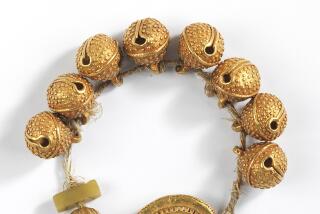Book Review : The Lost Gifts From China
- Share via
The Genius of China: 3,000 Years of Science, Discovery and Invention by Robert Temple (Simon & Schuster: $19.95)
One of the most extraordinary works of scholarship in recent years is Joseph Needham’s study of science and civilization in China, from which he has published 15 volumes of a projected 25 volumes since 1954. Needham is 86, but he continues his work at the Needham Research Institute at Cambridge University in Great Britain.
And what work it is! Needham has put together the almost unbelievable story of inventions and scientific discoveries that were made in China hundreds of years before they were made in the West. We myopically credit Johann Gutenberg with having invented movable type around 1436, but movable type was invented by a Chinese named Pi Sheng between 1041 and 1048.
A Chinese scientist named Shen Kua described the invention in a book published in 1086:
“During the reign of Ch’ing-li, Pi Sheng, a man of unofficial position, made movable type. His method was as follows: He took sticky clay and cut it in characters as thin as the edge of a coin. Each character formed, as it were, a single type. He baked them in a fire to make them hard. He had previously prepared an iron plate and he had covered his plate with a mixture of pine resin, wax and paper ashes. When he wished to print, he took an iron frame and set it on the iron plate. In this he placed the types, set close together. When the frame was full, and the whole made one solid block of type. . . .
‘Marvelously Quick’
“If one were to print only two or three copies, this method would be neither simple nor easy. But for printing hundreds of thousands of copies, it was marvelously quick. . . . For each character there were several types, and for certain common characters there were 20 or more types each, in order to be prepared for the repetition of characters on the same page. When the characters were not in use, he had them arranged with paper labels, one label for words of each rhyme-group, and kept them in wooden cases. If any rare character appeared that had not been prepared in advance, it was cut as needed and baked with a fire of straw. In a moment it was finished. . . .
“When Pi Sheng died, his font of type passed into the possession of my nephews, and up to this time it has been kept as a precious possession.”
I have quoted this passage at length because it shows how Needham backs up his assertions with incontrovertible evidence. From the description given in 1086, there is no doubt that Pi Sheng’s invention was in fact movable type as it came to be known in the West four centuries later.
But this is hardly the only example, or even the most remarkable. The Chinese invented a seismograph--yes, a seismograph--to detect distant earthquakes in AD 130, 1,400 years before the equivalent invention was made in the West. They knew and used chemical warfare, including poison gas and tear gas, in the 4th Century BC, 2,300 years before the West, and they had a decimal system of mathematics in the 14th Century BC, also 2,300 years before the West got around to it!
Just a Sampling
The Chinese were making cast iron in the 4th Century BC (1,700 years before the West), and they manufactured steel from cast iron in the 2nd Century BC (2,000 years before the West). The first suspension bridge was built in China in the 1st Century (at least 1,800 years before the West), and the Chinese invented matches in 577, a thousand years before the West.
And this description doesn’t begin to scratch the surface of what Needham has already filled 15 volumes with and proposes to fill 10 more volumes with, all of it solidly documented.
Now Robert Temple, an Oriental scholar in London, has distilled Needham’s work to one 254-page volume, beautifully printed and illustrated, that tells this astonishing story and whets the reader’s appetite for more.
Needham has written the introduction to Temple’s book, which he hails as “a brilliant distillation of my ‘Science and Civilisation’ in China.”
Needham goes on to ask the fundamental and unavoidable question posed by his and now Temple’s work: What happened? If the Chinese had such a head start in science and technology, why are they so far behind today? Needham asks, “First, why should they have been so far in advance of other civilizations; and second, why aren’t they now centuries ahead of the rest of the world?”
No Good Explanation
Oddly, Chinese science ended just as the Middle Ages were ending in Europe and Western science was getting under way. Just as oddly, neither Needham nor Temple nor anyone else has a good explanation for why science in China stopped.
Needham has uncovered one of the greatest and most overlooked stories in the history of science, and Temple has done an admirable job making it accessible to a wide audience.
Any reader will be amazed by this book.


